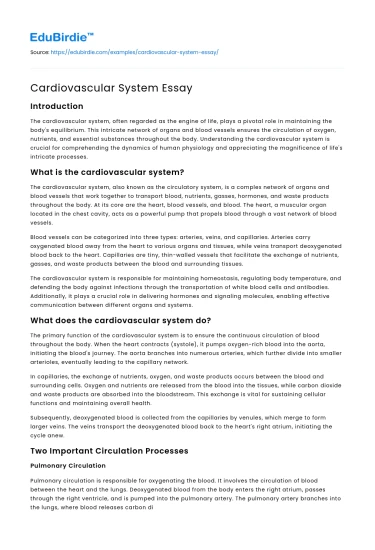Introduction
The cardiovascular system, often regarded as the engine of life, plays a pivotal role in maintaining the body's equilibrium. This intricate network of organs and blood vessels ensures the circulation of oxygen, nutrients, and essential substances throughout the body. Understanding the cardiovascular system is crucial for comprehending the dynamics of human physiology and appreciating the magnificence of life's intricate processes.
What is the cardiovascular system?
The cardiovascular system, also known as the circulatory system, is a complex network of organs and blood vessels that work together to transport blood, nutrients, gasses, hormones, and waste products throughout the body. At its core are the heart, blood vessels, and blood. The heart, a muscular organ located in the chest cavity, acts as a powerful pump that propels blood through a vast network of blood vessels.
Save your time!
We can take care of your essay
- Proper editing and formatting
- Free revision, title page, and bibliography
- Flexible prices and money-back guarantee
Blood vessels can be categorized into three types: arteries, veins, and capillaries. Arteries carry oxygenated blood away from the heart to various organs and tissues, while veins transport deoxygenated blood back to the heart. Capillaries are tiny, thin-walled vessels that facilitate the exchange of nutrients, gasses, and waste products between the blood and surrounding tissues.
The cardiovascular system is responsible for maintaining homeostasis, regulating body temperature, and defending the body against infections through the transportation of white blood cells and antibodies. Additionally, it plays a crucial role in delivering hormones and signaling molecules, enabling effective communication between different organs and systems.
What does the cardiovascular system do?
The primary function of the cardiovascular system is to ensure the continuous circulation of blood throughout the body. When the heart contracts (systole), it pumps oxygen-rich blood into the aorta, initiating the blood's journey. The aorta branches into numerous arteries, which further divide into smaller arterioles, eventually leading to the capillary network.
In capillaries, the exchange of nutrients, oxygen, and waste products occurs between the blood and surrounding cells. Oxygen and nutrients are released from the blood into the tissues, while carbon dioxide and waste products are absorbed into the bloodstream. This exchange is vital for sustaining cellular functions and maintaining overall health.
Subsequently, deoxygenated blood is collected from the capillaries by venules, which merge to form larger veins. The veins transport the deoxygenated blood back to the heart's right atrium, initiating the cycle anew.
Two Important Circulation Processes
Pulmonary Circulation
Pulmonary circulation is responsible for oxygenating the blood. It involves the circulation of blood between the heart and the lungs. Deoxygenated blood from the body enters the right atrium, passes through the right ventricle, and is pumped into the pulmonary artery. The pulmonary artery branches into the lungs, where blood releases carbon dioxide and takes up oxygen through the process of respiration. Oxygenated blood then returns to the heart through the pulmonary veins, entering the left atrium. Finally, it is pumped to the rest of the body through the aorta.
Systemic Circulation
Systemic circulation is responsible for delivering oxygenated blood to the body's tissues and organs. After the left atrium receives oxygenated blood from the lungs, it passes through the left ventricle, which pumps it into the aorta. The aorta distributes the oxygen-rich blood throughout the body via the network of arteries, arterioles, and capillaries. As the tissues receive the oxygen and nutrients they need, the blood becomes deoxygenated and returns to the heart through the veins, initiating the pulmonary and systemic circulation cycles.
Conclusion
The cardiovascular system serves as a lifeline, sustaining the body's intricate web of functions. Through pulmonary and systemic circulation, it ensures that every cell receives the necessary nutrients and oxygen while removing waste products. The harmonious interplay of the heart, blood vessels, and blood exemplifies the brilliance of biological engineering. Understanding this intricate system allows us to appreciate the delicate balance that keeps us alive and emphasizes the importance of maintaining cardiovascular health to lead a fulfilling life. Let us continue to marvel at the wonders of the cardiovascular system and nurture it through a healthy lifestyle.






 Stuck on your essay?
Stuck on your essay?

